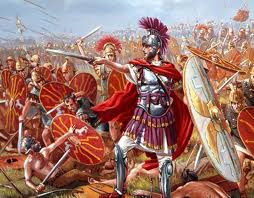They themselves say that their founders were brought up by the milk of a she-wolf; just so that the entire race as hearts of wolves, insatiable of blood, and ever greedy and lusting after power and riches.
– Mithridates of Pontus on the Romans (Justin 38.6.7-8)
If we were to look back at the early days of Republican Rome, say 400 BC or so, it would be difficult to see how these people would carve out one of the world’s greatest empires. Rome was just one of many city-states of the Latin people located in modern day central Italy and, in many ways, was not dissimilar to the fractured civilization of the Greeks. The Latin peoples fought amongst themselves just as the Greeks had done. The Greeks used hoplites and phalanx tactics in battle similar to the Romans during their time in the early republic. Rome, being the largest and most powerful of these city-states, could even be argued as the Latin version of the Greek polis Athens. So how did a group of people heavily reliant on farming and agriculture and at constant odds with each other manage to carve out one of the largest and glorious empires in the history of man?
Rome was just one of many city-states of the Latin people located in modern day central Italy and, in many ways, was not dissimilar to the fractured civilization of the Greeks. The Latin peoples fought amongst themselves just as the Greeks had done. The Greeks used hoplites and phalanx tactics in battle similar to the Romans during their time in the early republic. Rome, being the largest and most powerful of these city-states, could even be argued as the Latin version of the Greek polis Athens. So how did a group of people heavily reliant on farming and agriculture and at constant odds with each other manage to carve out one of the largest and glorious empires in the history of man?
[Livy 8.8] [Fields, 13-15]
 Rome, unlike their Greek counterparts, was able to subjugate her rival city-states by the late 4th century BC and united them under the single banner of the city of Rome. At this time the culture of Rome when it came to warfare changed and she adopted a radical policy of expansionism that eventually set her at odds with other civilizations on the Apennine Peninsula, such as the Etruscans, Samnites and other smaller mountain tribes. It is unclear exactly why Rome did not make attempts to peacefully coexist with her neighbors or even how the poor agricultural masses just accepted the policy of compulsory military service dictated by their aristocratic senate. Some experts speculate that Roman aggression arose simply by the ambition of the republic’s leading politicians to swell the area of Roman influence through conquest; while others say that the constant infighting among the Latin people had drilled an attitude of mistrust so deeply into the minds of the Roman people that any neighboring civilization could be viewed as a potential threat to the safety of the Roman lands. Regardless of the source of this expansionist policy, the Romans threw themselves into a series of wars with their Etruscan and Samnite neighbors spanning from the late fourth to early third centuries BC. By the conclusion of the Third Samnite War in the Early 3rd century BC, the Romans had done away with the old phalanx and hoplite style of warfare and had adopted the Manipular formation (methods believed borrowed from their Samnite foes); transforming Rome into a sophisticated and powerful fighting force using complex tactics requiring unimaginable military discipline.
Rome, unlike their Greek counterparts, was able to subjugate her rival city-states by the late 4th century BC and united them under the single banner of the city of Rome. At this time the culture of Rome when it came to warfare changed and she adopted a radical policy of expansionism that eventually set her at odds with other civilizations on the Apennine Peninsula, such as the Etruscans, Samnites and other smaller mountain tribes. It is unclear exactly why Rome did not make attempts to peacefully coexist with her neighbors or even how the poor agricultural masses just accepted the policy of compulsory military service dictated by their aristocratic senate. Some experts speculate that Roman aggression arose simply by the ambition of the republic’s leading politicians to swell the area of Roman influence through conquest; while others say that the constant infighting among the Latin people had drilled an attitude of mistrust so deeply into the minds of the Roman people that any neighboring civilization could be viewed as a potential threat to the safety of the Roman lands. Regardless of the source of this expansionist policy, the Romans threw themselves into a series of wars with their Etruscan and Samnite neighbors spanning from the late fourth to early third centuries BC. By the conclusion of the Third Samnite War in the Early 3rd century BC, the Romans had done away with the old phalanx and hoplite style of warfare and had adopted the Manipular formation (methods believed borrowed from their Samnite foes); transforming Rome into a sophisticated and powerful fighting force using complex tactics requiring unimaginable military discipline.
[Raaflaub, 273-314]

After finally overcoming the Samnites and Etruscans the Romans found themselves in possession of most of modern day Italy, however, the Romans had no intention of stopping there. The Romans then turned their eyes to new conquests and campaigns. Campaigns that would take them through modern day France and Germany fighting the Gallic tribes. The arduous Punic Wars that would transverse the Mediterranean Sea into Africa against the mighty Carthaginians. Conquests that finally united the Greek city states, under the banner of Rome. In this web presentation, we hope to explain and explore how the Roman military machine was able to conquer and subjugate such a large area of the world encompassed by many different groups of people and methods of fighting with such unparalleled success.

